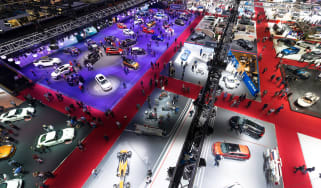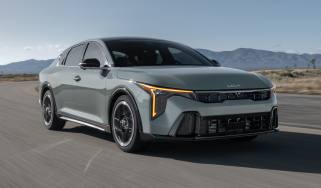New Smart #6 will be a VW Golf-sized electric hatchback
Smart's upcoming electric hatchback is set to bring the brand into the mainstream, and our exclusive image shows what it could look like

Smart will expand its line-up to four models next year, with the new addition to be known as the #6. It’s likely to be the first hatchback to join a currently SUV-only range.
A replacement for the baby ForTwo and ForFour models is still some way off, though, with the brand unable to make the costs stack up for small cars. But it has held back the #2 or #4 nameplates while it seeks a partner to help make the project profitable.
This means the larger car comes first, and speculation has it pinned as a hatchback, although it’s described only as “surprising and exciting from a design and technology point of view” by insiders. It’s expected to be revealed in the second half of next year, before hitting the road in 2026.
“We have promised one car per year and have fulfilled this so far,” Smart’s European CEO Dirk Adelmann told Auto Express in an exclusive interview. Although he wouldn’t be drawn on what the car was, he confirmed it wouldn’t be an SUV.
“There will be a fourth car from us in year number four,” Adelmann continued. “We now have three SUVs in the line-up, with #3 being a SUV/Coupé crossover. There is a market besides that bodystyle, and we definitely want to address that – with a hatchback or another body type.
“We are investing heavily in a time when there is a lot of uncertainty in and around electric cars, particularly in Europe,” he continued. “And that shows you that Smart, now with 26 years of existence and heritage, is here to stay, is here to make an impact, and is here to be one of the main forces to drive sustainable mobility – not only urban, but also extra-urban.”
As you can see from our exclusive image of how a Smart #6 could look, the car is expected to be a C-segment (Volkswagen Golf-sized) hatchback taking cues from the existing #1 and #3 models, rather than the chunkier looks of the new #5. This would be a good time to build a hatchback, given that Mercedes-Benz, which owns a joint majority share in Smart with Chinese manufacturer Geely, is set to end production of the A-Class in the next two years.
Adelmann said Smart is also increasing its UK dealer network, in part through Mercedes dealers seeing the two brands sitting well together on the same site.
“When they [Mercedes] are thinning out their portfolio in the C-segment, Smart is the natural bridge for those customers who will not get a Mercedes in that segment anymore,” he said. “So they are happy to have us in the showrooms, and we are happy to be the bridge for those customers stepping up from another brand to Smart, then maybe from Smart to Mercedes in the future.”
Although it’s not yet confirmed, the new #6 would likely use the battery and motor set-up from the #3 and #1, which offers 47kWh and 62kWh battery options and power outputs of 268bhp or, in the Brabus performance versions, 422bhp.
It would also most likely sit on parent company Geely’s Sustainable Experience Architecture (SEA) , which underpins the #1 and #3.
Although development of the #6 is already well under way, Smart has yet to find a solution for how to produce a replacement for its most iconic model, the ForTwo.
It was the car that launched the company back in 1998, so a modern interpretation of the two-seat city car would seem an obvious choice for today’s all-electric brand.
The company has reserved the #2 and #4 model names in the hope it will form a partnership with another brand to make launching the models economical, but nothing is confirmed.
“We have reserved the even numbers on purpose, as the tool we will use when the time is right,” Adelmann told Auto Express. “We are working on it, we are looking, obviously as a brand, at a two-seat option, but we’ve been doing that for a long, long time.”
Adelmann said the technology and crash test requirements make it hard to build profitable small cars, which have low profit margins.
“There is a reason why it’s very difficult for any OEM to be successful in the A-segment, because the technology is more or less the same [as bigger cars], the GSR (General Safety Regulation) 2.0 requirements on assistance systems are exactly the same, Euro NCAP is exactly the same,” he continued. “You simply cannot price for it, and that is still an industry-wide dilemma.
“We hear our customers, we hear our retailers that are also pushing us, and we have two million people in Europe that have driven or are driving the ForTwo or FourFour, so a two-seater is something we’re working on, but have not decided on yet.”
Smart’s pledge of one new car per year means it would be 2027 at the earliest before a new #2 would arrive, with the #3 coupé-SUV having launched this year, the chunky #5 coming next year, and the #6 scheduled to arrive in 2026.
Talking about potentially collaborating with another brand on a small car, Adelmann referenced past co-operations with Mitsubishi and Renault as evidence of Smart’s previous success. The first ForFour was also a Mitsubishi Colt, while the more recent ForTwo and ForFour shared their underpinnings with the Renault Twingo.
Fancy a compact EV? These are the best small electric cars to buy...







